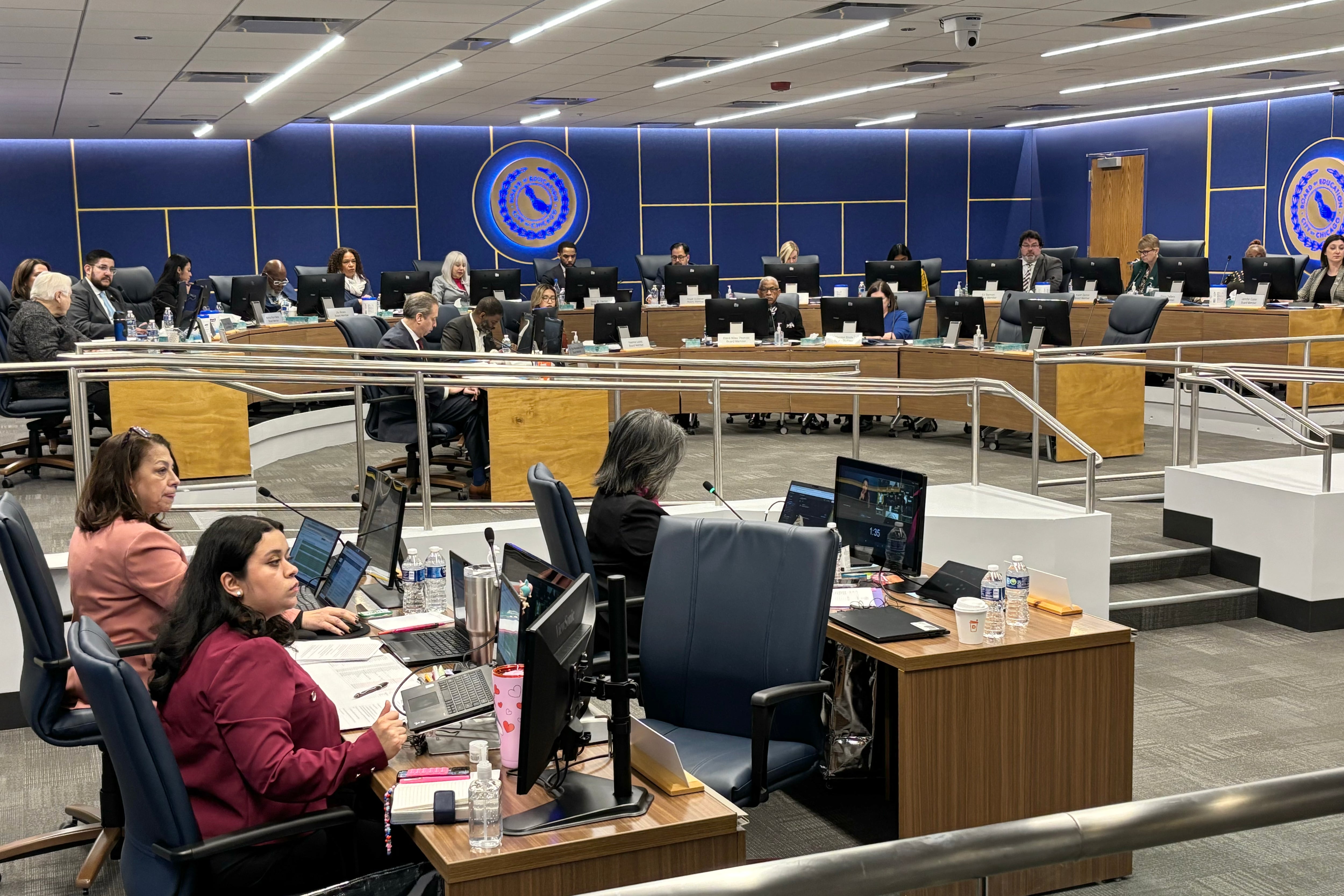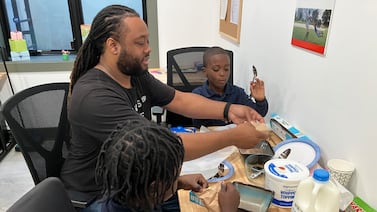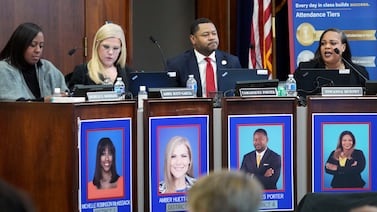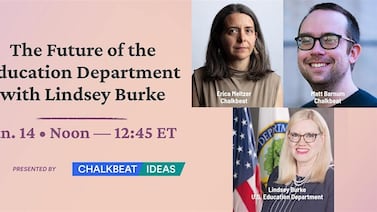Data analysis by Thomas Wilburn
Sign up for Chalkbeat Chicago’s free daily newsletter to keep up with the latest news on Chicago Public Schools.
The Chicago Teachers Union was the biggest spender in Chicago’s first school board elections, which pitted the union against pro-school choice groups as both angled for influence on a new, partly-elected board.
Overall, between candidates’ own war chests and money spent separately by political action groups and super PACs, more than $13 million flowed in the run-up to the historic November elections, a Chalkbeat analysis of campaign disclosures from late March to the end of December filed with the Illinois State Board of Elections found.
Brisk spending has become a hallmark of school board races in large urban districts. The Chicago total — which includes spending by both candidates and interest groups — outpaced spending in districts such as Denver and Detroit. In Los Angeles, however, nearly $15 million was spent on its school board races in 2020. Teachers unions have often faced off against pro-charter and school choice groups, but — unlike in Chicago — unions have usually spent less than those groups.
“This is not a typical school board election in any way, shape, or form,” said Jonathan Collins, assistant professor of political science and education at Teachers College at Columbia University. “It’s an entirely new system at a critical moment when education is arguably more politicized than we’ve ever seen.”
Last fall, Chicago residents elected 10 board members, including one who ran unopposed; they were sworn in alongside 11 mayoral appointees on Jan. 15. In 2026, all 21 seats on the board will be up for grabs at the ballot box.
Candidates raised more than $5.6 million between March 26, when they could first begin gathering signatures to get on the ballot, and Dec. 31, 2024. They reported $3.3 million in expenditures during the same period.
In addition to candidates’ direct spending, the union’s two political action committees spent $4.3 million — including a $1.5 million spending spree the week of the election — during that same time period. In some cases that spending could have also given a boost to other candidates in other races, but most went to nine candidates in contested school board races, three of whom won seats on the board.
Two pro-school choice super PACs — those for the Illinois Network of Charter Schools and Urban Center — jointly spent roughly $3.5 million during the same period. These groups also backed three candidates who prevailed at the polls.
In some cases, Illinois Board of Elections disclosures can include errors or duplicate spending reports by candidate campaigns and political action committees spending on their behalf. The latter groups also do not always list specific candidates when they report expenditures. State law requires campaign finance disclosures be filed every quarter. The latest ones, which covered the final quarter of 2024, were due Jan. 15.
Chalkbeat’s analysis of financial disclosures comes after a historic and hotly contested election season that saw the union and charter camps trading sharp words ahead of election day. Each accused the other of aiming to buy board seats: The CTU slammed the charter group for leaning on large checks from deep-pocketed donors, including from out-of-state billionaires such as Netflix CEO, Democratic mega donor, and charter supporter Reed Hastings. The charter group said it wanted to push back at a time when it said city leaders are hostile to charter, selective enrollment, and magnet schools. Some candidates also called out the CTU for sending voters direct mail portraying candidates — including active longtime Democrats — as puppets of now President Donald Trump.
The CTU declined to answer specific questions related to its campaign finance reports. But in a statement, the union said the expense was necessary to advocate for high-quality neighborhood schools and ensure “public school champions were the biggest bloc of candidates Chicagoans chose to represent them.”
“We fought hard to create the elected school board and shouldn’t have had to fight so hard or spend so much to counter the influence of out-of-state billionaires and forces of privatization,” the statement said.
The Illinois Network of Charter Schools spent about $2.3 million in the election’s nine contested races, backing candidates in some and opposing CTU-endorsed candidates in others. Andrew Broy, the network’s executive director, said the expense was worth it.
“Somebody had to be a counterweight to the million-plus dollars the CTU was going to spend to promote their agenda,” he said.
Chicago voters also elected three candidates who benefited from neither CTU or pro-school choice spending. Two of these candidates, Jessica Biggs and Therese Boyle, had some of the smallest war chests and spent the least per vote they earned, suggesting there are clear limitations to how much money can buy in the city’s fledgling school board elections.
Bruce Leon, an independent candidate in District 2 on the North Side who loaned himself $620,000 of his own money, had the largest war chest of any school board candidate. He finished second to CTU-backed Ebony DeBerry.
Despite the wave of spending, the teachers union and others who supported an elected school board have called for additional campaign spending limits specifically for Chicago school board elections.
Currently, candidates running for office in Illinois are bound by limits on how much they can raise, such as $6,900 from an individual contributor and $13,700 from a corporation or a labor union. But super PACs are not subject to those limits. And as spending to back or oppose any one candidate exceeds $100,000, the campaign contribution caps for all candidates in that district are lifted. In most Chicago school board districts, spending by the Illinois Network of Charter Schools and Urban Center lifted those caps by early October.
Collins, at Columbia University, said there’s only so much the city and state could do, given the U.S. Supreme Court’s 2010 Citizens United decision cementing the ability of super PACs to spend with few restrictions, as long as they don’t coordinate directly with candidates’ campaigns.
Collins, who has followed school board campaign spending in recent years, says that roughly $1 million per seat has been typical in large urban district board elections. And the spending standoff between teachers union and charter advocates has also become a fixture of such races across the country, from Providence, Rhode Island, to San Francisco.
“In large urban districts in blue states especially, those have been the two prize fighters in the ring,” Collins said.
It’s unusual, however, to see a teachers union, which usually leans more on its ability to put boots on the ground for door-knocking and phone-banking, outspend pro-school choice groups so handily, he said. Those groups have had a clear financial edge in other cities.
According to Board of Elections disclosures, the union’s political committee spent more than $500,000 on field work between March 26 and Dec. 31.
According to Chalkbeat’s analysis, candidates and political groups in Chicago spent a combined $3.8 million on direct mail to voters, almost $1.2 million on digital ads, and nearly $500,000 on text messaging, among other expenditures.
Urban Center Action — the pro-school choice PAC run by former UNO charter network head Juan Rangel and affiliated with Paul Vallas, the former Chicago Public Schools CEO who lost the 2023 Chicago mayoral race to Johnson — spent about $1.1 million, mainly on field work.
Broy, of the charter network, said the CTU holds a “structural advantage” in being able to draw on dues from its almost 30,000 members, forcing advocacy groups like his to rely on large checks from a relatively small number of individuals to compete. Broy also questioned the CTU practice of underwriting smaller political groups that used funding from the union to support CTU-endorsed candidates — a practice that, had the spending caps remained in place, could help circumvent them.
But Matt Dietrich, a spokesman for the state Board of Elections, said his agency has received no formal complaints about spending in the school board races. The board sent a letter to CTU leadership in the fall asking why the union has two separate political action committees — a potential campaign rules violation.
Dietrich said it is possible that one PAC is affiliated with the union and another with its foundation. The board has not received a response from the union.
Asked about the final price tag of the election, Dietrich said, “No amount would surprise me given how quickly the spending limits came off, and the big players who got involved.”
Broy said the network is already recruiting candidates and fundraising for the 2026 school board race.
“I think there’ll be a lot of interest in that election,” he said.
Between his appointees and CTU-backed elected candidates, Johnson appears poised to hold continued influence over the board’s decisions in the next two years. But Collins, the Teachers College expert, said the intense spending clash in last year’s board races raises the possibility of a divided, gridlocked board in the district’s not-too-distant future.
“Will they be able to agree on tough budget decisions that will keep the district afloat?” Collins said.
Mila Koumpilova is Chalkbeat Chicago’s senior reporter covering Chicago Public Schools. Contact Mila at mkoumpilova@chalkbeat.org.
Becky Vevea is the bureau chief for Chalkbeat Chicago. Contact Becky at bvevea@chalkbeat.org.







